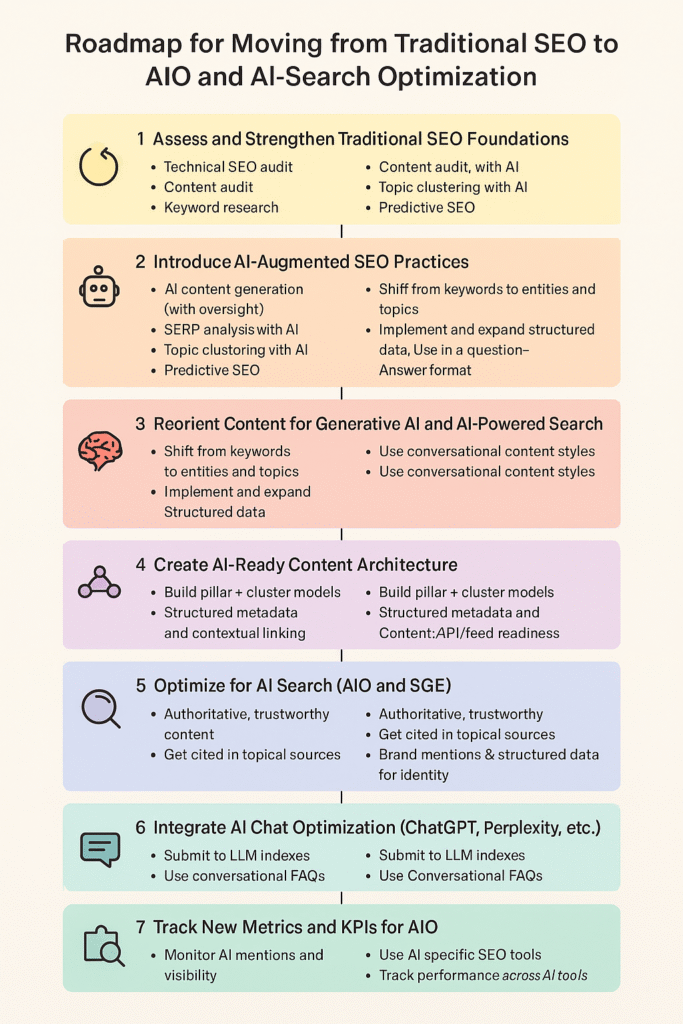Table of Contents
The search landscape is no longer what it used to be. Gone are the days when stuffing keywords or chasing backlinks guaranteed a spot at the top of Google. Today, Artificial Intelligence (AI) is reshaping how users find information, with conversational interfaces like Google’s AI Overviews, ChatGPT, and Perplexity prioritizing user intent and context over rigid keyword matches. For SEO specialists, digital marketing professionals, CMOs, and CDOs, this shift demands a new approach: AI-Search Optimization.
This isn’t just a buzzword—it’s a strategic necessity. AI-driven search engines don’t just crawl websites; they interpret content, understand relationships between ideas, and deliver answers in real-time. To stay visible and competitive, your organization must evolve from traditional SEO to a future-ready framework that embraces AI-Search Optimization. In this 3,300-word guide, I’ll walk you through a four-phase roadmap to make that transition, packed with actionable steps, real-world examples, and insights tailored to MarTech leaders. Let’s dive in.
Phase 1: Laying the Groundwork with Traditional SEO Excellence
Goal: Build a rock-solid SEO foundation, because even AI-driven search relies on technical health, quality content, and user experience.
Before you can master AI-Search Optimization, your website needs to nail the basics. Think of traditional SEO as the foundation of a house—AI-Search Optimization is the sleek, modern extension you’re adding. Without a sturdy base, the whole structure collapses. Here’s how to ensure your SEO foundation is ready.
Step 1: Run a Comprehensive SEO Audit
Start with a deep dive into your website’s health. A thorough audit uncovers issues that could hinder both traditional and AI-driven search performance.
- Technical SEO: Use tools like Google Search Console, Screaming Frog, or Sitebulb to check crawlability, indexation, and site architecture. Look for broken links, duplicate content, or missing HTTPS. Test site speed with Google PageSpeed Insights—aim for a score above 90. Confirm mobile-friendliness, as Google’s mobile-first indexing is non-negotiable. Add structured data markup (Schema.org) to give search engines context, and double-check your XML sitemap and robots.txt for accuracy. Example: A mid-sized e-commerce brand found that 15% of its product pages weren’t indexed due to a faulty sitemap. Fixing this boosted organic traffic by 12% in two months.
- On-Page SEO: Review content quality, keyword alignment, and user intent. Are your title tags (under 60 characters) and meta descriptions (under 160 characters) compelling? Do headings (H1, H2, H3) create a clear hierarchy? Optimize URLs to be concise and descriptive. Strengthen internal linking to guide users and crawlers to related content. Most importantly, ensure your content is in-depth, accurate, and engaging.
- Off-Page SEO: Evaluate your backlink profile with Ahrefs or Moz. Prioritize links from high-authority, relevant sites. Monitor brand mentions using Google Alerts or Brandwatch to gauge your online reputation.
Step 2: Refine Your Keyword and Topic Strategy
Keywords still matter, but the game has changed. AI-Search Optimization requires a focus on user intent and topical authority, not just search volume.
- Conduct keyword research with SEMRush, Ahrefs, or Google Keyword Planner. Map keywords to the customer journey—awareness, consideration, decision—to align with what users need at each stage.
- Shift from standalone keywords to broader topics. Identify core topics your audience cares about and brainstorm subtopics to create content clusters. For example, a SaaS company might build a pillar page on “Customer Relationship Management” with clusters on CRM features, integrations, and pricing.
- Plan a content calendar that prioritizes pillar pages (comprehensive guides) and cluster content (supporting articles). This approach signals expertise to both Google and AI-driven platforms.
Step 3: Elevate Content Quality and Depth
Great content is the heart of both SEO and AI-Search Optimization.
- Aim for long-form content (1,500+ words) that answers user questions thoroughly. A B2C fitness brand, for instance, could publish a 2,000-word guide on “Building a Home Workout Routine,” covering equipment, schedules, and nutrition.
- Mix formats—text, images, videos, infographics—to keep users engaged. A well-placed chart or video can make complex ideas more accessible.
- Structure content for readability with clear headings, bullet points, and short paragraphs. This helps humans scan and AI crawlers parse your pages.
Step 4: Bolster Technical Infrastructure
A fast, accessible website is critical for AI-Search Optimization.
- Optimize speed by compressing images, using CDNs, and enabling browser caching. Target a Largest Contentful Paint (LCP) under 2.5 seconds, per Core Web Vitals.
- Implement structured data (e.g., Article or Product schemas) to make content machine-readable.
- Design a logical site architecture where most pages are reachable within three clicks. This improves crawlability and user navigation.
- Prioritize mobile usability, as over 60% of searches happen on smartphones.
Step 5: Enhance User Experience (UX)
UX isn’t just about aesthetics—it’s a ranking factor.
- Create intuitive navigation and clear CTAs. A retailer might simplify its menu to reduce clicks to checkout, cutting cart abandonment rates.
- Optimize for Core Web Vitals: fast loading (LCP), minimal layout shifts (CLS), and quick interactivity (FID).
- Ensure readability across devices with accessible fonts, colors, and layouts.
Takeaway: A strong SEO foundation sets the stage for AI-Search Optimization by ensuring your site is crawlable, relevant, and user-friendly.
Phase 2: Getting Smart About AI and AIO Prep
Goal: Educate your team on AI’s role in search and start optimizing for AI-friendly techniques.
AI-driven search engines like Google’s AI Overviews or Perplexity don’t just match keywords—they understand context, entities, and conversational queries. To prepare for AI-Search Optimization, you need to think like an AI while keeping your audience front and center.
Step 1: Train Your Team
Your team needs to understand the shift to AI-driven search.
- Host workshops on Natural Language Processing (NLP) and machine learning, explaining how AI interprets user intent and entities (e.g., people, places, concepts). Share examples like Google’s Gemini, which improved query understanding for 10% of searches.
- Discuss why AI-Search Optimization matters for your business. For CMOs and CDOs, tie it to ROI—better visibility means more leads and conversions.
- Foster collaboration between SEO, content, and tech teams to align on goals.
Step 2: Master Entity Optimization
Entities are the building blocks of AI-Search Optimization.
- Identify key entities for your business using Google’s Knowledge Graph Search API or Wikidata. A travel agency might focus on entities like “budget travel,” “European destinations,” or “solo travel.”
- Create content that defines and connects these entities. A post on budget travel could link to related entities like “affordable accommodations” or “travel deals.”
- Use consistent terminology to reinforce entity relationships across your site.
Step 3: Craft Content for Direct Answers
AI often delivers concise answers, not just links.
- Anticipate user questions and provide clear, direct responses. For example, a tech company might answer “What is cloud computing?” with a one-sentence definition followed by a detailed explanation.
- Use FAQ schema markup to highlight question-answer pairs, increasing your chances of appearing in AI-generated summaries or featured snippets.
- Organize answers under clear headings (H2, H3) for easy scanning.
Step 4: Embrace Natural Language
AI excels at conversational queries, so your content should too.
- Write in a natural, human-like tone. Instead of targeting “best project management tools,” optimize for “What are the best project management tools for startups?”
- Include semantic keywords and related terms. Tools like MarketMuse or Clearscope can suggest phrases to enrich your content.
- Study query patterns with AnswerThePublic or Google Search Console to mirror how your audience searches.
Step 5: Leverage AI-Powered SEO Tools
AI tools can give you a competitive edge in AI-Search Optimization.
- Use SurferSEO or Frase for keyword research, content gap analysis, and intent mapping.
- Experiment with Alli AI to automate on-page tweaks, like optimizing meta tags or internal links.
- Group keywords by topical relevance to build content clusters that align with AI’s focus on authority.
Takeaway: Phase 2 equips your team to think like AI, optimizing for entities, natural language, and direct answers.
Phase 3: Rolling Out AIO and Embracing AI-Search
Goal: Actively optimize for AI algorithms and prepare for the AI-Search ecosystem.
Now it’s time to put AI-Search Optimization into action. This phase focuses on comprehensive content, authority building, and technical readiness to shine in AI-driven search results.
Step 1: Build Holistic Content Strategies
Forget one-off keyword posts—AI rewards depth and breadth.
- Develop content clusters around core topics, with a pillar page linking to supporting articles. A healthcare provider might create a pillar on “Preventive Care” with clusters on screenings, nutrition, and exercise.
- Use SEMRush Topic Research to uncover subtopics and questions your audience asks.
- Ensure content is authoritative, covering every angle of a topic to dominate search results.
Step 2: Boost Content Authority
Authority is a currency in AI-Search Optimization.
- Publish original research, like industry reports or case studies, to establish thought leadership. A digital agency might release a report on “2025 MarTech Trends.”
- Encourage reviews and testimonials on platforms like G2 or Trustpilot to build trust.
- Partner with authoritative sites through guest posts or co-created content to amplify your reach.
Step 3: Optimize for AI Overviews and Featured Elements
AI search loves concise, structured data.
- Write direct answers to common questions to land in featured snippets or AI-generated summaries. A pet store could answer “How often should I feed my dog?” with a clear, bulleted response.
- Use structured data (e.g., HowTo or FAQ schemas) to make content machine-readable.
- Format information in lists or tables for easy AI parsing.
Step 4: Fine-Tune Technical Foundations for AI
AI crawlers have unique needs.
- Ensure robots.txt allows access for AI crawlers (e.g., don’t block “ChatGPT-User”).
- Use clean HTML/Markdown and a clear site structure to simplify content interpretation.
- Prioritize fast delivery by placing key information above the fold.
- Consider APIs or RSS feeds to make content programmatically accessible to AI platforms.
- Adopt agent-responsive design, ensuring interactive elements like forms are clear to AI.
Step 5: Track AI Search Performance
AI-Search Optimization requires constant monitoring.
- Test your content on platforms like ChatGPT or Perplexity to see how it’s interpreted. Does your guide on “cybersecurity best practices” show up in relevant AI responses?
- Use Google Analytics or Clarity to analyze AI-driven traffic and user behavior.
- Follow industry updates via Search Engine Journal or Moz to stay ahead of AI search trends.
Takeaway: Phase 3 makes your brand a standout in AI-driven search through strategic content and technical excellence.
Phase 4: Sustaining Success in an AI-First World
Goal: Make AI-Search Optimization a core part of your long-term strategy.
AI-Search Optimization isn’t a one-and-done project—it’s an ongoing commitment. This phase ensures your organization stays agile and user-focused as AI continues to evolve.
Step 1: Integrate AIO with Marketing
AI-Search Optimization should amplify your broader efforts.
- Repurpose pillar content for social media or email campaigns to maximize reach.
- Align with paid advertising teams to target conversational queries on platforms like Google Ads.
- Use social listening tools like Sprout Social to identify trending topics for content.
Step 2: Prioritize User Value
AI serves users first, so your content must solve real problems.
- Address pain points with practical solutions. A financial services firm might create a guide on “Managing Student Loan Debt” to resonate with young professionals.
- Collect feedback via surveys or comments to refine your approach.
- Focus on accessibility and clarity to align with AI’s user-centric goals.
Step 3: Rethink Metrics
Traditional SEO metrics don’t tell the full story.
- Track engagement (time on page, scroll depth) and conversions (leads, sales) to measure impact.
- Monitor how often your content appears in AI-generated responses using tools like RankRanger or manual testing.
- Tie AI-Search Optimization to business outcomes, like customer acquisition or retention, to justify investment.
Step 4: Keep Testing and Learning
The AI landscape moves fast—stay nimble.
- Stay updated through webinars, whitepapers, or X communities focused on SEO and AI.
- Test new formats, like interactive calculators or short videos, to see what drives engagement.
- Experiment with optimization tweaks, such as different FAQ structures, to optimize for AI.
Step 5: Foster a Forward-Looking Mindset
Change is the only constant in AI-Search Optimization.
- Invest in training via Coursera or HubSpot Academy to keep your team sharp.
- Explore emerging trends, like voice search or AR integration, through small pilots.
- Build a culture of experimentation, encouraging your team to test and iterate.
Takeaway: Phase 4 embeds AI-Search Optimization into your DNA, ensuring long-term success.
The following is a high-level diagram showing the roadmap moving from Traditional SEO to AIO and eventually AI Search.

This serve as a guide for SEO specialist moving from traditional SEO to AIO and AI-Search. You can run the activities concurrently if you have the capacity and team in place.
Wrapping Up: Your Path to AI-Search Optimization
The shift to AI-Search Optimization is a game-changer for MarTech professionals. By building a strong SEO foundation, embracing AI-driven techniques, implementing AIO, and committing to continuous improvement, your organization can lead the pack in an AI-first world. This roadmap isn’t just a checklist—it’s a strategic framework to drive visibility, engagement, and growth.
Don’t wait. Audit your site, train your team, and test AI-friendly content today. With AI-Search Optimization, you’re not just keeping up—you’re staying ahead.
Read “Unveiling Google I/O 2025: Revolutionizing Traditional SEO with AI Overview“










